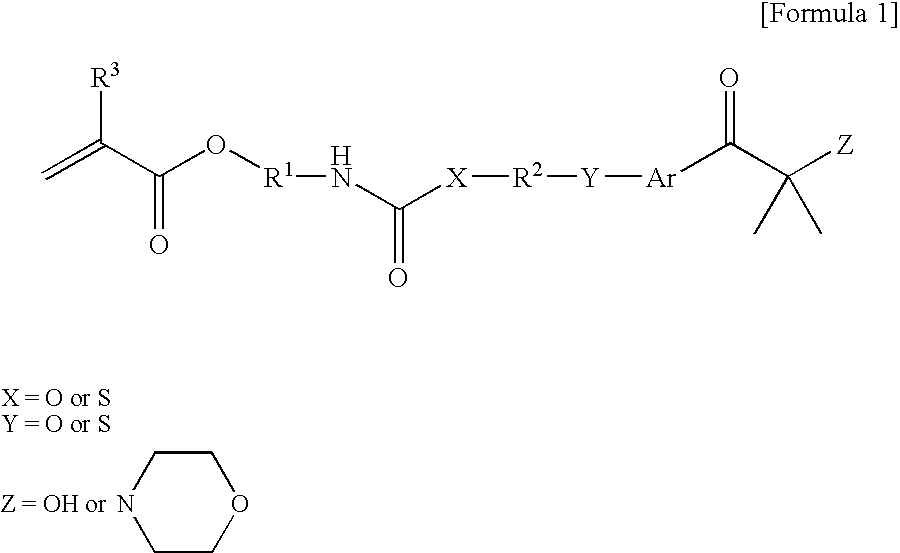Liquid Crystal Sealing Material and Liquid Crystal Display Cell Using Same
- Summary
- Abstract
- Description
- Claims
- Application Information
AI Technical Summary
Benefits of technology
Problems solved by technology
Method used
Image
Examples
synthesis example 1
(a) Synthesis 1 of a Reactive Photopolymerization Initiator
[0058] 155 g of 2-isocyanateethyl methacrylate (Karenz MOI, manufactured by Showa Denko KK) as a radically reactive (meth)acrylate monomer having an isocyanate group and 224 g of 2-hydroxy-4′-hydroxyethoxy-2-methylpropiophenone (IRG-2959, manufactured by Chiba Speciality Chemicals Corp.) as an aryloyl compound having a hydroxy group were put in a reaction vessel, and 0.76 g of methylhydroquinone as a polymerization inhibitor was added thereto. The temperature of the mixture was raised to 80° C., and the mixture was stirred for about 26 h at said temperature. The obtained reaction solution was dissolved in a mixture solvent of methyl isobutyl ketone and toluene, and washed with water. Thereafter, methyl isobutyl ketone and toluene were distilled out, and a targeted reactive photopolymerization initiator represented by the following structural formula:
was obtained by recrystallization using ethyl acetate and n-hexane.
synthesis example 2
(a) Synthesis 2 of a Reactive Photopolymerization Initiator
[0059] 155 g of 2-isocyanateethyl methacrylate (Karenz MOI, manufactured by Showa Denko KK) as a radically reactive (meth)acrylate monomer having an isocyanate group and 325 g of 1-[4-[2-(-mercaptoethyl)-thio]phenyl]-2-methyl-2-(4-morpholino)-1-propanone (CGI967, manufactured by Chiba Speciality Chemicals Corp.) as an aryloyl compound having a thiol group were put in a reaction vessel, and dissolved in 320 g of toluene; and 0.96 g of methylhydroquinone as a polymerization inhibitor was added thereto. The temperature of the mixture was raised to 80° C., and the mixture was stirred for about 32 h at said temperature. The obtained reaction solution was dissolved in a mixture solvent of methyl isobutyl ketone and toluene, and washed with water. Thereafter, methyl isobutyl ketone and toluene were distilled out to obtain a targeted reactive photopolymerization initiator represented by the following structural formula:
example 1
[0061] 7.2 pts.wt. of the reactive photopolymerization initiator synthesized in Synthesis Example 1, 120 pts.wt. of an epoxy acrylate of bisphenol F epoxy resin (YDF-8170C, epoxy equivalent: 160 g / eq, manufactured by Tohto Kasei Co., Ltd.), 30 pts.wt. of RE-203 (ethylene oxide-added bisphenol S epoxy resin, epoxy equivalent: 233 g / eq, manufactured by Nippon Kayaku Co., Ltd.) as an epoxy resin and 0.2 pts.wt. of an aminosilane coupling agent (N-β(aminoethyl)γ-aminopropyltrimethoxysilane, manufactured by Shin-Etsu Silicones Co., Ltd. KBM-603) were heated and dissolved at 90° C. to obtain a resin solution. The resin solution was cooled to room temperature, then added with 10.1 pts.wt. of adipic dihydrazide (trade name: ADH; a jet mill-pulverized grade manufactured by Otsuka Chemical Co., Ltd. was further finely pulverized), 25 pts.wt. of alumina (manufactured by, SPC-A1, average particle size: 1.0 μm) and 5.8 pts.wt. of a rubber (Paraloid EXL-2655, manufactured by Osaka Kasei Co., Ltd....
PUM
| Property | Measurement | Unit |
|---|---|---|
| Photocurable | aaaaa | aaaaa |
Abstract
Description
Claims
Application Information
 Login to View More
Login to View More - R&D
- Intellectual Property
- Life Sciences
- Materials
- Tech Scout
- Unparalleled Data Quality
- Higher Quality Content
- 60% Fewer Hallucinations
Browse by: Latest US Patents, China's latest patents, Technical Efficacy Thesaurus, Application Domain, Technology Topic, Popular Technical Reports.
© 2025 PatSnap. All rights reserved.Legal|Privacy policy|Modern Slavery Act Transparency Statement|Sitemap|About US| Contact US: help@patsnap.com



